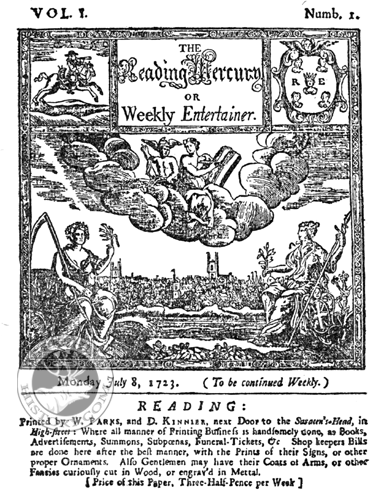 |
 |
|||
|
 The Reading
Mercury The Reading
MercuryOne of the Country's Earliest Newspapers On Monday 8th July 1723, there appeared in Reading the first number of a newspaper which called itself the Reading Mercury, or Weekly Entertainer. It consisted of twelve pages. The printed part of each page covered a space not more than five and a quarter inches wide by seven inches long. On the outer page was a picture of the town of Reading. The paper was to appear weekly and its cost was three-halfpence a copy. Inside the first number was a letter from the printers addressed to the Mayor and to the public. The printers observed that the art of printing had spread far and wide, and that it was now fitting for Reading to have a newspaper of its own. They promised to publish trustworthy news, "and when a scarcity of news happens we shall divert you with something merry." They then gave a short account of Berkshire and of Reading. They said that Reading market was reputed one of the best in England for all sorts of grain and provisions, and that the meadows within the borough were noted for their fertility. The rest of the first number consisted of scraps of news and a few advertisements. We read that a prodigious whale had been caught near Rhode Island; that a Dutch ship had been attacked by pirates; that a subterraneous fire had broken out in Kent; that a murder had taken place near Shrewsbury; that someone had won £10,000 in a lottery; that a man had been robbed by footpads; and that a Reading man had been killed in a cart accident. From 1723 up to 1987 – over two hundred and fifty years - the Reading Mercury appeared every week and, at the time of its demise was one of the oldest newspapers in the kingdom. Known for most of its life for the coverage of news from Reading, Berkshire and South Oxfordshire, before the late 18th century, there was actually no regular slot in it for local news. Full-time reporting of local events was only introduced in the 19th century. It was issued under various extensions of the name over the years: The Reading Mercury and Oxford Gazette (1767-1831), The Reading Mercury, Oxford Gazette and Berkshire County Paper (1831-1839) and The Reading Mercury, Oxford Gazette, Newbury Herald and Berkshire County Paper (1839-1960). From 1960, it was simply the Reading Mercury and, from 1970, the Berkshire Mercury. The paper owed its origin to John Watts who, in 1723, was Mayor of Reading. John Watts was a very energetic man. He not only founded the Reading Mercury, but he raised money in order to make a better road between Caversham and Reading and engaged in other useful works for the benefit of the town. He died in 1750 and was buried in St. Laurence's Church. The paper was printed by William Parks & David Kinnier, the first printers in Reading. They were based next door to the Saracen's Head in the High Street, but soon moved to London, leaving the Reading Mercury to be produced by William Carnan until his death in 1737. He left the paper to his widow, Mary, and brother, Charles. Two years later, Mary married her husband's assistant of seven years, John Newbery from Waltham St. Lawrence. Newbery retained part-ownership of the Mercury, but settled in London to become a famous publisher of children's books. In 1762, Carnan's daughter, Anna Maria, and her poet husband Christopher Smart, became proprietors of the newspaper; but the marriage broke-up and Mrs. Smart ran the business for over forty years, firstly with her brother, John, and then, from 1785, with Thomas Cowslade, husband of her elder sister, Marianne. The Cowslades inherited the business upon Anna Maria's death in 1809 and held it for another hundred years. As time went on, taxes and duties caused newspapers to become very expensive. In 1800, for example, the Reading Mercury cost seven-pence a copy. People used sometimes to borrow a copy from a neighbour and pay a halfpenny or a penny for permission to read it. The early volumes of the Reading Mercury contain much valuable information about old times in the town and the surrounding neighbourhood. During the first part of the 19th century, the editors of the paper rendered most useful service by interesting Reading people in great questions, such as the reform of Parliament and the introduction of railways; and also in questions nearer home, such as the necessity of a better system of drainage and water supply. Partly edited from W.M. Childs' "The Story of the Town of Reading" (1905)
|
|||
| © Nash Ford Publishing 2017. All Rights Reserved. | ||||





